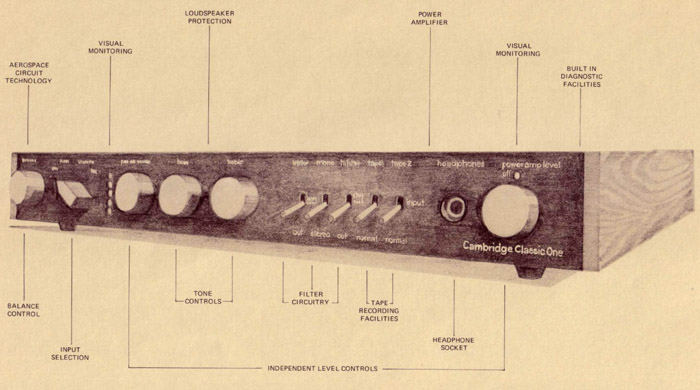The Cambridge Audio Classic One integrated amplifier
The Classic One was launched by Cambridge Audio in 1976 and was the most advanced amplifier of its era incorporating a wealth of new ideas and new technologies. At the time everyone who heard it declared it to be in a class of its own significantly in advance of the existing well regarded Cambridge amplifiers like the P60 and P110. A batch of 200 amplifiers was built at the St. Ives factory and initially a few teething problems associated with the then new multi-layer printed circuit boards had to be sorted out. The first batch of amplifiers was sent out in small quantities to distributors around the world and big sales looked likely. Unfortunately at that stage the owners of Cambridge Audio decided to move production to a large electronics factory they had purchased in Byfleet, Surrey and to close down the Cambridgeshire factory making the very experienced production team redundant. After this move I left the company to join Lecson and the new factory struggled to make any of the Cambridge products and reverted to making the existing P60 & P80 amplifiers and no more Classics were built. This move also saw the end of another potentially exciting Cambridge product; the Musician amplifier.
Plans existed, together with a prototype, of a follow-on product; the Classic Two amplifier which was built into a double height case of much the same design but with a bigger power supply; double sized heatsinks, twice the number of output transistors and thus a hefty power output of over 100 watts per channel.
 A super slim design in the Cambridge Audio tradition of the 1970s A super slim design in the Cambridge Audio tradition of the 1970s
At the time Cambridge Audio was a sucessful company with distribution around the world including the USA and Canada where the parent company, C.E. Hammond & Co, the Revox distributor, had subsidiary companies. The product line in 1976 comprised the P60 and P110 integrated amplifiers; the T55 FM Stereo Tuner; and the R50 and R40 transmission line loudspeakers. Cambridge Audio was the sales company with manufacturing being done by a sister company, Lamb Laboratories Ltd. which was based in St. Ives. Lamb Labs. also made a number of pre-audio & disco audio products plus disco lighting systems sold under the name Meteor Light & sound.
The impetus behind the design of the Classic One was to replace the P110, a 50 watt per channel amplifier, with a more modern design and one that would be more profitable. Before starting work we borrowed all the leading amplifiers of the era and found that with the exception of the Crown DC300A we had little to learn. However new ideas were hitting the amplifier world and one of these was the concept of "Transient Intermodulation Distortion". TIM was built up into something special but came down to little more than ensuring that the power amplifier stage had a good open-loop frequency response; that is before negative feedback was applied.
 A sketch of the Classic One taken from the brochure which had to be prepared before the first samples were ready, hence the use of an artist's impression. It was actually drawn with coloured chalks on paper; the good old fashioned way. A sketch of the Classic One taken from the brochure which had to be prepared before the first samples were ready, hence the use of an artist's impression. It was actually drawn with coloured chalks on paper; the good old fashioned way.
Phono Amplifier. The design started with the phono amplifier which in those days was designed for a moving magnet cartridge such as the Shure V15. The residual noise level was very low, within 2dB of the theoretical minimum and the input overload level was almost 50 dB so giving a tremendous dynamic range. The input signals were switched by conventional switches but a second switch fitted slightly ahead operated a FET muting circuit which avoided any "clicks" and faded the sound up gradually after changing the input source. The filters offered in the Classic were also extraordinary for the time. The HF filters were linear phase fourth order Bessel filters introducing minimal phase delays whilst the low-frequency filter (often called a rumble filter) was a unique cascaded Twin-T and Sallen-Key filter having a slope of greater than 50dB per octave compared to the typical 12 dB per octave filters then in use. This new filter was like a cliff face!
The Classic One was designed to be used with up to three tape recorders and had two gain controls; a conventional Volume control just ahead of the power amplifier and an active gain control in the pre-amplifier which set the dynamic range. In addition there was a 5 step LED level indicator so that the gain control could be set accurately. Almost all the active circuitry in the pre-amplifier stages was contained in unique Cambridge Audio micro circuits custom made by Newmarket Transistors. The silicon substrate contained the transistors and resistors, all of which were matched to 0.1% accuracy ensuring that both channels tracked each other exactly. The best components were used throughout in this amplifier including metal oxide resistors of 0.5% tolerance; all mounted on a multi-layer circuit board -- something almost beyond the state-of-the-art at the time.
The power amplifier stands comparison with the best available today. The design offered an unusually wide power bandwidth with outstanding stability. Indeed a square wave could be driven into a 10 mFD load and still be reproduced as a clean square wave with virtually no ringing. By comparison most amplifiers of the era would go into uncontrolled ringing and instability and would probably blow up!
I could continue because there were many other novel features so it was a real pity that this amplifier never reached many owners - they would have loved the sound; even today.
|

